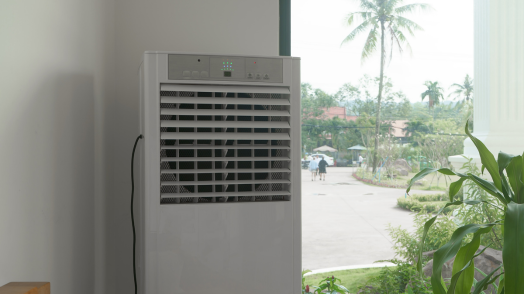What Is An Evaporative Cooling System?
Evaporative cooling is a popular temperature-reducing method that dates back to the Ancient Egyptians, Romans, and Eary Anglo Settlers. But how does this method work, what are the benefits, and is it appropriate for all workplace environments?
This article will discuss how evaporative cooling works, its benefits and potential limitations, and where it’s most effectively used.
What Is Evaporative Cooling?
Also known as adiabatic cooling, evaporative cooling is a natural and energy-efficient method of reducing temperature using water evaporation. Unlike traditional air conditioning systems that rely on refrigerants and compressors, evaporative cooling harnesses the power of water and airflow to cool down indoor spaces. It’s based on a simple physical principle: when water evaporates, it absorbs heat from the surrounding air, resulting in a drop in temperature.
How Does Evaporative Cooling Work?
Evaporative cooling works by converting water into vapour using the heat in the surrounding air, lowering the air temperature. During this process, the heat in the air is absorbed to evaporate the water. When water evaporates, it needs to absorb energy to transition from a liquid to a vapour. This energy is drawn from the surrounding air in the form of heat, leading to a decrease in the air temperature. Here is a step-by-step breakdown of how evaporative cooling systems work:
- Warm Air Intake: The system draws in warm, dry air from the outside environment via ducting or tubing.
- Water Saturation: This warm air is passed through large water-saturated pads or filters.
- Evaporation Process: As the warm air passes through the wet pads, the water in the pads evaporates. During this process, the water absorbs heat from the air, which cools it.
- Cool Air Distribution: The now-cooled air is then blown into the indoor space by a fan, lowering the overall temperature of the environment (isenthalpic process).
The cooling effect is more pronounced in environments with dry air because dry air can hold more water vapour, making the evaporation process more efficient. The drier the air, the more water it can absorb, and the more effective the cooling process will be.
The Benefits of Evaporative Cooling
Evaporative cooling offers several advantages over traditional air conditioning systems, especially in the right conditions:
- Energy Efficiency: Evaporative cooling systems use significantly less energy than conventional air conditioners because they don’t use compressors or refrigerants.
- Lower Operational Costs: Reduced energy usage results in lower electricity bills, making evaporative cooling a more cost-effective solution.
- Environmentally Friendly: Since evaporative cooling doesn’t use refrigerants, which can harm the environment, it’s a sustainable alternative to traditional air conditioning.
- Natural Air Circulation: Evaporative cooling systems provide fresh air from the outside rather than recirculating indoor air, which can improve indoor air quality.
- Easy Maintenance: Compared to traditional HVAC systems, evaporative coolers are simpler in design and easier to maintain. Regular maintenance typically involves cleaning or replacing the cooling pads, ensuring adequate water supply, and checking the fan.
Potential Limitations and Considerations
While evaporative cooling has many benefits, some limitations need to be considered:
- Climate Dependency: Evaporative cooling is most effective in hot, dry climates. In regions with high humidity, the system becomes less efficient because the air is already saturated with moisture, reducing the potential for evaporation.
- Moisture Control: In areas with moderate humidity, evaporative cooling can increase indoor humidity levels, potentially leading to mould growth.
- Limited Cooling Range: Unlike traditional air conditioners that can cool spaces to very low temperatures, evaporative coolers typically lower temperatures by about 5-10°C, which may not be sufficient in extremely hot conditions.
- Water Usage: Evaporative cooling systems require a continuous water supply to operate, which can be a concern in areas where water conservation is a priority.
Where Can Evaporative Cooling be Used?
Evaporative cooling systems are most effective in dry, hot climates with low humidity levels, such as Nevada, Iran, and Egypt. These systems are commonly used in homes as a cost-effective alternative to air conditioning. Evaporative cooling is also used in large warehouses, factories, and commercial spaces to help maintain comfortable working conditions for employees without incurring high energy costs.
In summary, evaporative cooling is a natural, cost-effective, and energy-efficient method of cooling that leverages the simple yet powerful process of water evaporation to reduce indoor temperatures. It offers significant advantages in terms of cost savings, environmental impact, and ease of maintenance, especially in dry climates where it performs best.
However, it’s essential to consider the limitations, such as its dependence on climate and the potential to increase humidity levels. When used in the right environment, evaporative cooling can be a highly effective solution for maintaining comfortable indoor and outdoor spaces while minimising energy consumption and environmental impact.

